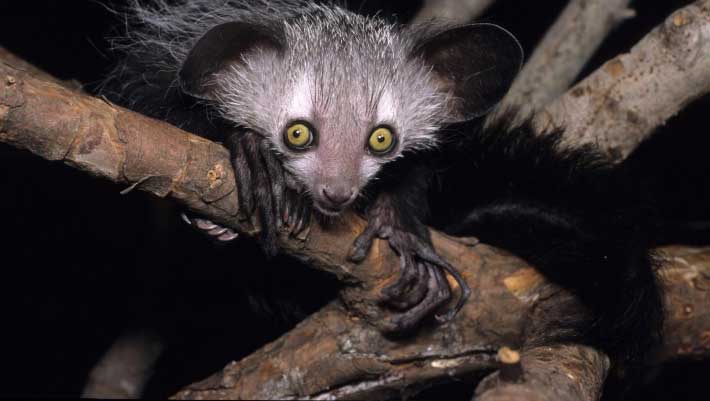In the lush and mysterious forests of Madagascar, a creature with a peculiar appearance and a most unconventional appendage thrives—the Aye-Aye. Standing out among its lemur relatives, the Aye-Aye’s eccentric finger is not only an oddity but also a key tool in its quest for survival. Join us as we delve into the enigmatic world of the Aye-Aye and its extraordinary finger, a remarkable example of evolutionary ingenuity.
The Aye-Aye: Madagascar’s Nocturnal Oddball
The Aye-Aye (Daubentonia madagascariensis) is a species of lemur characterized by its large, round eyes, bat-like ears, and a bushy tail. However, what truly sets the Aye-Aye apart is its elongated and skeletal middle finger, which has earned it a place among the most bizarre adaptations in the animal kingdom.
The Finger’s Purpose: Tapping into Survival Strategies
The Aye-Aye’s remarkable finger serves a dual purpose—navigation and food acquisition. This unique adaptation is a prime example of nature’s ability to sculpt specialized tools tailored to the challenges of a particular environment.
Foraging Technique: Drumming for Dinner
The Aye-Aye employs a distinctive foraging technique that involves tapping on tree bark with its elongated middle finger. As it taps, the Aye-Aye listens for the hollow echoes produced by cavities within the wood. Once a hollow chamber is detected, the Aye-Aye uses its specialized finger to extract wood-boring insect larvae, a primary food source for these nocturnal creatures.
Adaptation to Nocturnal Life: The Finger as a Sensory Marvel
In addition to its foraging function, the Aye-Aye’s finger showcases remarkable sensory adaptations. The finger is equipped with a specialized thin, bony structure that allows it to serve as a highly sensitive probe. This sensitivity is crucial for the Aye-Aye’s nocturnal lifestyle, where the sense of touch becomes paramount in the darkness of the Madagascan night.
Misunderstood and Superstitious Beliefs: A Threat to the Aye-Aye
Despite the fascinating adaptations of the Aye-Aye’s finger, this lemur species faces threats from superstitions and cultural beliefs. In some regions, the Aye-Aye is considered an omen of bad luck, leading to persecution. Conservation efforts are essential to dispel misconceptions and protect this unique primate from unnecessary harm.
Conservation Challenges: Preserving Madagascar’s Ecological Marvels
Madagascar, known for its high level of endemism, faces challenges in conserving its unique biodiversity. Habitat loss, deforestation, and cultural biases against certain species, including the Aye-Aye, pose significant threats. Conservation initiatives that address both ecological preservation and community awareness are vital to safeguarding Madagascar’s natural treasures.
Conclusion: The Aye-Aye’s Finger as a Symbol of Adaptation
The Aye-Aye’s eccentric finger stands as a symbol of nature’s capacity for adaptation and innovation. While its appearance may be strange to human eyes, it is a marvel of evolution perfectly suited to the challenges of the Madagascan ecosystem. As we unravel the mysteries of the Aye-Aye and its extraordinary finger, we gain insight into the wondrous diversity of life and the delicate balance that sustains Earth’s unique inhabitants.

